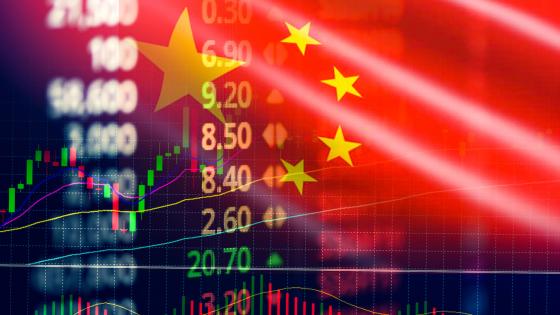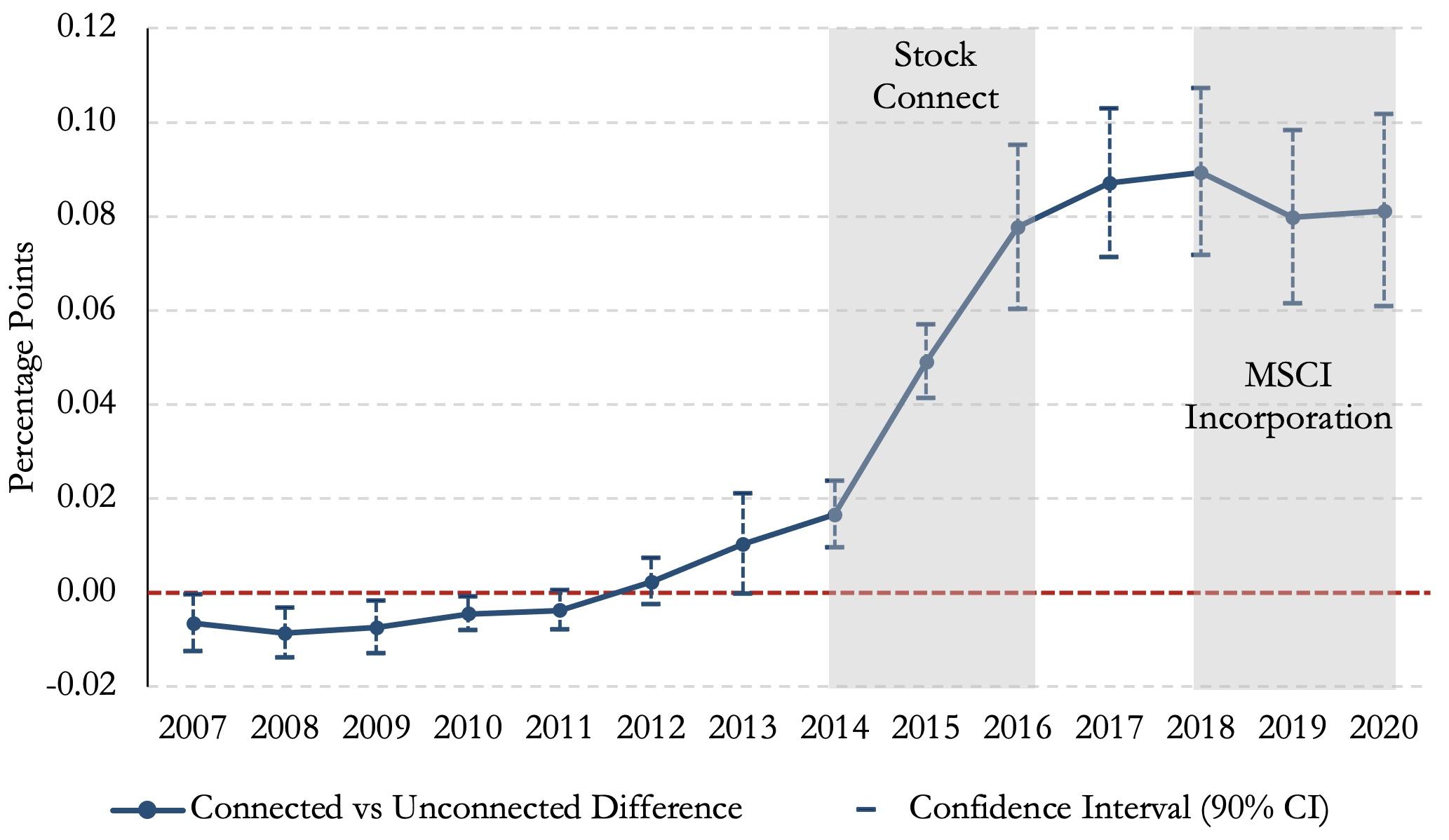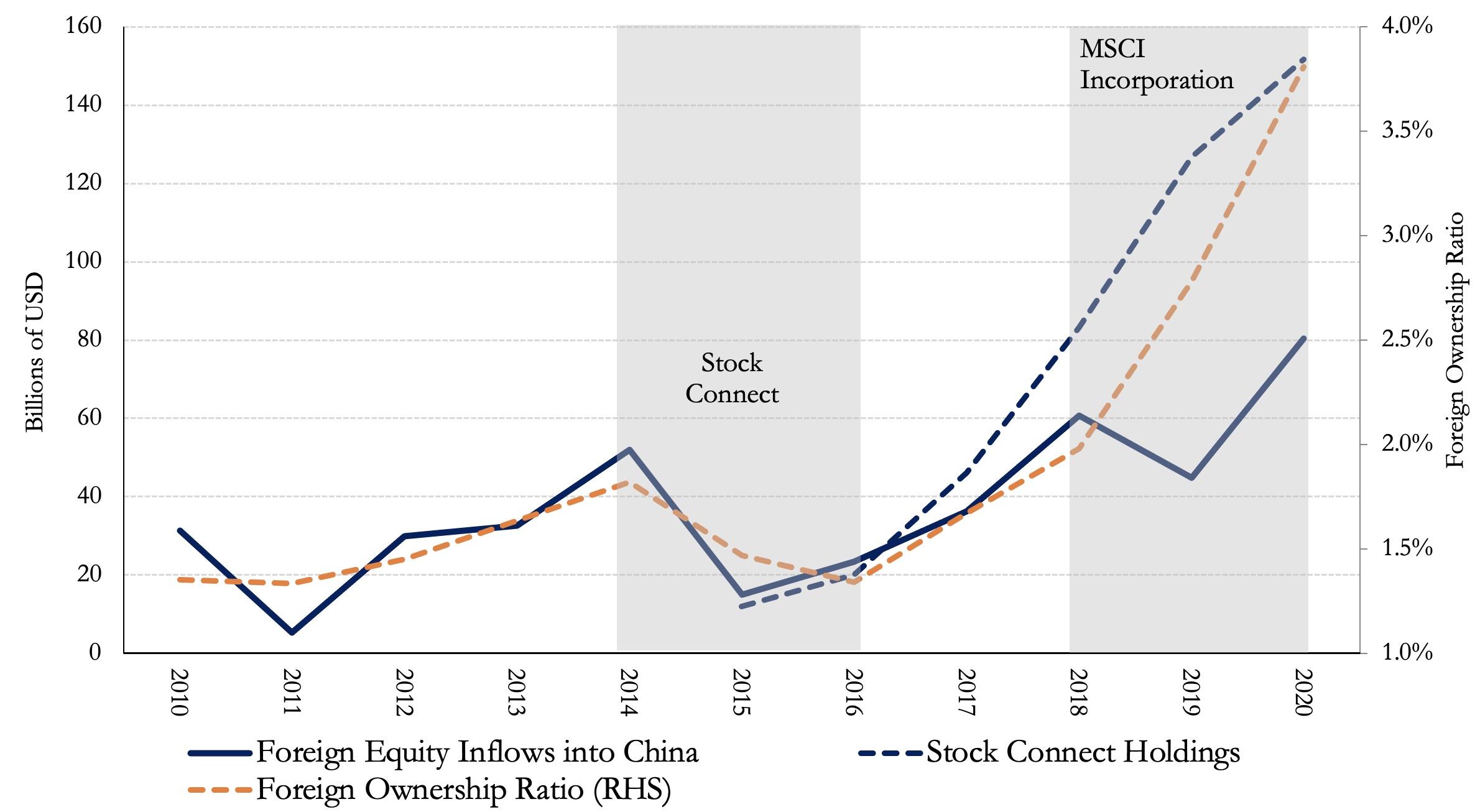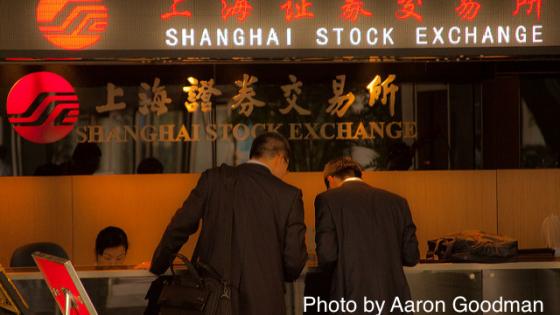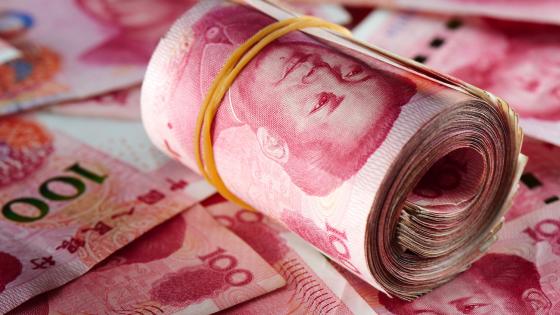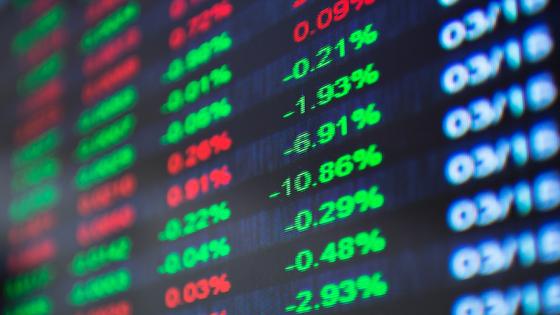Chinese capital markets are the second largest in the world and have attracted increasing attention as they are crucial for firms and investors worldwide (Cerutti and Obsteld 2019, Clayton et al. 2023). Until recently, foreign investors have had limited access to the Chinese markets. However, the internationalisation of China’s equity markets has substantially accelerated in the past decade. Still, there is little evidence regarding the response of firms and investors to the different internationalisation episodes.
Foreign investors were first granted access to Chinese equity markets in 2002 through a programme limited to a few foreign institutions. Following relatively small expansions of institution-specific programmes, the internationalisation process gained significant momentum after 2012. Since 2014, foreign retail and institutional investors worldwide can access the Chinese equity markets directly through the Hong Kong Stock Exchange via the Stock Connect program. Since 2018, Chinese stocks have been gradually included in the Morgan Stanley Capital International (MSCI) Emerging Market Index, a benchmark closely followed by foreign investors.
Chinese equity markets have grown significantly since the internationalisation process accelerated. The domestic equity market capitalization in China tripled between 2014 and 2020, growing faster than the GDP and the market capitalization in Hong Kong and Singapore (Figure 1).
Figure 1 Equity market capitalisation
Note: This figure shows domestic listed firms’ total equity market capitalization in mainland China, Hong Kong, and Singapore. Values are expressed in billions of 2011 U.S. dollars (USD). The shaded areas capture the implementation of the Qualified Foreign Institutional Investor programs (QFII and RQFII), the implementation of the Stock Connect program, and the incorporation of domestic listed stocks from China into the MSCI Emerging Markets Index. RHS: Right Hand Side.
Source: Cortina et al. (2023).
Firm financing and investment
The internationalisation process targeted firms listed in the Chinese domestic equity markets. However, only a select group of ‘connected’ domestic listed companies were included in the Stock Connect programme and MSCI index, leaving the rest of the domestic listed firms ‘unconnected’. By contrast, Chinese firms listed overseas and in Hong Kong already had access to foreign financing before the internationalisation events.
Firms subject to the internationalisation episodes substantially increased their equity financing and investments compared to other firms (Cortina et al. 2023). Although both targeted and untargeted firms showed a similar pattern in equity issuances up to 2013, targeted firms increased their equity issuances relative to untargeted firms since 2014. Connected firms increased their equity issuances relative to unconnected firms (listed domestically) and relative to those listed in foreign markets (Figure 2). By 2020, the cumulative amount of equity raised (over initial assets) was 51 percentage points higher for connected firms than for unconnected firms with similar starting characteristics.
Figure 2 Cumulative equity raised over 2012 assets
Note: This figure presents trends in equity issuance activity for different groups of publicly listed firms with residence and operations in mainland China. It shows the average cumulative equity raised per type of firm and year over 2012 assets.
Source: Cortina et al. (2023).
Connected firms also increased their capital expenditures, acquisitions of other firms, research and development (R&D) expenditures, and short-term investments (including cash) relative to unconnected firms during 2014-20. The difference in equity issuance and investment between the two types of firms peaked during 2015-17. This difference remained significant in subsequent years. Concurrent shocks, including the Chinese government intervention in 2015 (Huang et al. 2016), did not impact these estimates.
Figure 3 Differences in capital expenditures
Note: This figure shows differences in investment behavior (for capital expenditures) between connected and unconnected firms with similar balance sheet characteristics in 2010-12. The figure plots the average differences in capital expenditures over 2012 assets for each year between connected and unconnected firms.
Source: Cortina et al. (2023).
At the aggregate level, the internationalisation process played a significant role in the amount of equity issued and investments by domestic listed companies. About 28% of the total equity raised, 10% of capital expenditures, 12% of acquisitions, 24% of R&D expenditures, and nearly a quarter of cash and short-term investments made by domestic listed firms during 2013-20 could be associated with this process (Cortina et al. 2023).
Foreign investors’ entry
Foreign investors reacted to the internationalisation process relatively late. Foreign equity investments increased in 2014, but the most rapid expansion was observed during 2018-20, after MSCI incorporated Chinese stocks (Figure 4). For instance, foreign equity inflows went from about US$15 billion in 2015 to over $80 billion in 2020. Foreign equity holdings through the Stock Connect programme, which channelled the expansion in foreign participation, rose from $15 billion in 2015 to 151 billion in 2020. Firms’ foreign ownership ratio went from 1.5% in 2015 to 3.8% in 2020. Although it increased with the MSCI inclusion, China’s weight in emerging market portfolios has lagged behind the MSCI weight. By 2020, China accounted for approximately 40% of the MSCI Emerging Markets Index and less than 30% of the emerging market equity portfolios (Cortina et al., 2023).
The fact that foreign equity inflows were smaller than domestic equity issuances during the 2014-16 Stock Connect implementation suggests that domestic investors provided most of the equity financing for domestic firms. Foreign investors increased their participation when the MSCI Emerging Market Index incorporated the Chinese stocks. This is consistent with international investors closely following equity benchmark indexes (Raddatz et al. 2016, Kashyap et al. 2018).
Figure 4 Foreign equity investment into China
Note: This figure shows the evolution of foreign equity investment in China. It shows annual foreign equity portfolio inflows into China, the outstanding value of foreign equity holdings through the Stock Connect program, and the average foreign ownership ratios across domestic listed firms. Values are expressed in billions of 2011 U.S. dollars (USD). RHS: Right Hand Side.
Source: Cortina et al. (2023).
Conclusion
The financial and real benefits of China’s equity market internationalisation for domestic firms are significant and spanned multiple years. Exceptionally high savings rates in China before and during the internationalisation events might have allowed connected firms to obtain domestic financing and fuel their growth, until foreign investment started to trickle in during the late 2010s.
The evidence from China could overstate the benefits of internationalisation for other emerging economies without a strong domestic investor base and high saving rates. But for relatively closed countries with a larger foreign investor pool willing to invest, the results for China could also understate the benefits of further internationalisation.
Several factors are likely to increase foreign investor presence in China. First, despite growing in recent years, foreign investors own less than 5% of the outstanding shares in China. This percentage is significantly lower than in other emerging economies, indicating the potential for greater foreign participation (Cerrutti and Obsetld 2019). Second, as long as China’s weight in emerging market equity portfolios lags behind its weight in the MSCI Emerging Markets Index that investors follow, a catch-up in foreign investments could be expected. Third, China’s weight in the MSCI index will likely continue to increase. Initially, MSCI included Chinese stocks at 5% of their overall free-float market capitalization. In 2019, this inclusion factor was increased to 20% and may continue to rise in future MSCI revisions. Fourth, China’s internationalisation efforts are still ongoing. In 2023 China added over 1,000 new connected firms to the Stock Connect. As a result, about 90% of the total market capitalization is now open to foreign investors, prompting them to increase their portfolio investments in Chinese stocks (The Economist 2023).
Internationalising China’s equity markets could also have implications for other emerging economies. Evidence shows that other emerging economies have suffered capital outflows due to China’s inclusion in the MSCI Emerging Market Index (Antonelli et al. 2022). As China’s presence in emerging market portfolios grows, the risk of capital outflows for other countries rises. This could harm firms’ financing and investment activities in other emerging markets, especially for those with greater dependence on external funding.
References
Antonelli, S, F Corneli, F Ferriani and A Gazzani (2022), “Benchmark effects from the inclusion of Chinese A-shares in the MSCI EM Index”, Economics Letters 216, 110600.
Clayton, C, A Dos Santos, M Maggiori and J Schreger (2023), “Internationalising like China,” VoxEU.org, 27 January.
Cerutti, E and M Obstfeld (2019), “China’s bond market and global financial markets,” in A Schipke, M Rodlauer, and L Zhang (eds), The Future of China’s Bond Market, International Monetary Fund.
Cortina, J J, M P Martinez Peria, S L Schmukler and J Xiao (2023), “The internationalization of China’s equity markets,” IMF Economic Review, forthcoming.
Huang, Y, J Miao and P Wang (2023), “Saving China’s stock market,” VoxEU.org, 8 November.
Kashyap, A K, N Kovrijnykh and A Pavlova (2021), “Why asset managers create subsidies for certain firms”, VoxEU.org, 18 February.
Raddatz, C, S L Schmukler and T Williams (2016), “The effects of benchmarks on international capital flows: the problems of passive investing,” VoxEU.org, 12 August.
The Economist (2020), “Chinese officials promise foreign investors greater access,” 5 April.
